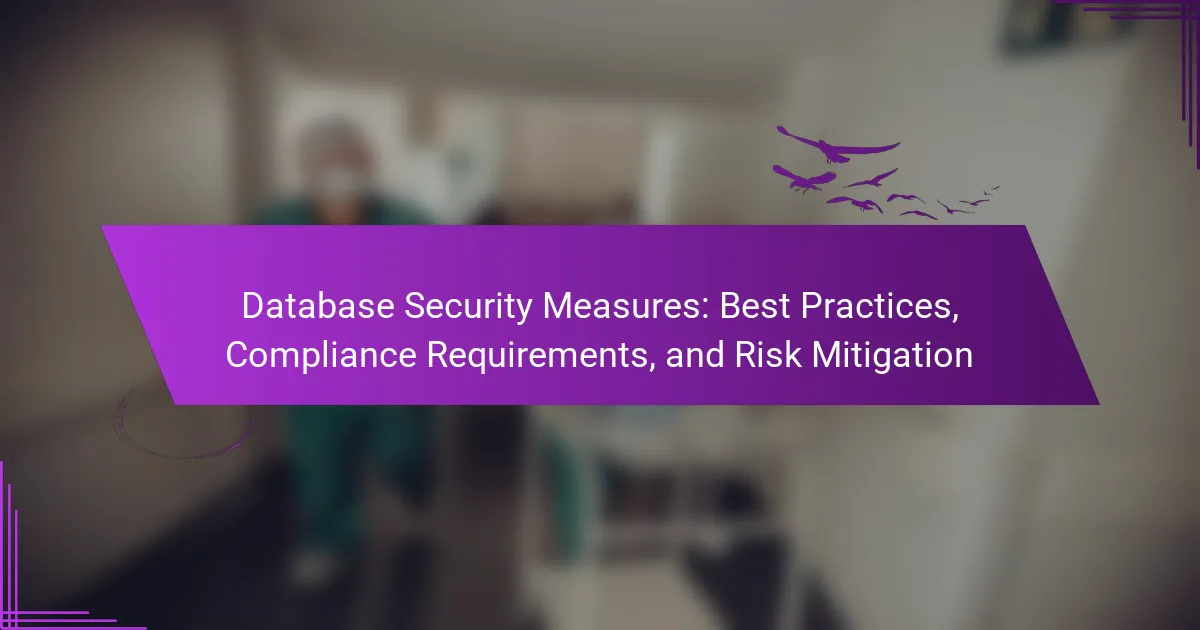
What are Database Security Measures?
Database security measures are strategies and practices designed to protect databases from unauthorized access, breaches, and data loss. These measures include encryption, which secures data by converting it into a coded format. Access controls restrict who can view or modify data, ensuring only authorized users have permissions. Regular backups are essential for data recovery in case of loss or corruption. Intrusion detection systems monitor for suspicious activity and alert administrators. Database activity monitoring tracks and analyzes database transactions for anomalies. Compliance with regulations, such as GDPR or HIPAA, mandates specific security protocols to protect sensitive information. These measures collectively enhance the overall security posture of database systems.
How do Database Security Measures protect data?
Database security measures protect data by implementing various controls to safeguard against unauthorized access and data breaches. These measures include encryption, which secures data at rest and in transit, making it unreadable to unauthorized users. Access controls restrict user permissions, ensuring only authorized personnel can view or modify sensitive information. Regular audits and monitoring detect suspicious activities, enabling timely responses to potential threats. Firewalls act as barriers between trusted internal networks and untrusted external networks, filtering incoming and outgoing traffic. Additionally, backup and recovery solutions ensure data can be restored in case of loss or corruption. According to the 2021 Data Breach Investigations Report by Verizon, 61% of data breaches involved credential theft, emphasizing the need for robust security measures.
What types of threats do these measures defend against?
Database security measures defend against various threats including unauthorized access, data breaches, and SQL injection attacks. These measures implement user authentication and access controls to prevent unauthorized access. They also utilize encryption to protect sensitive data from breaches. Additionally, regular security audits and monitoring help detect and mitigate potential threats. Firewalls and intrusion detection systems are deployed to block malicious activities. Compliance with regulations like GDPR and HIPAA further strengthens data protection. Together, these practices create a robust defense against evolving cybersecurity threats.
How do Database Security Measures ensure data integrity?
Database security measures ensure data integrity by implementing controls that protect data from unauthorized access and alterations. These measures include access controls, encryption, and auditing. Access controls restrict who can view or modify data. Encryption secures data in transit and at rest, preventing unauthorized access. Auditing tracks changes and access to data, ensuring accountability. Together, these measures maintain data accuracy and reliability. For example, organizations that implement these practices can reduce data breaches by up to 80%, according to a study by the Ponemon Institute.
Why are Database Security Measures essential for organizations?
Database security measures are essential for organizations to protect sensitive data. They prevent unauthorized access and data breaches. According to a report by IBM, the average cost of a data breach in 2021 was $4.24 million. Effective security measures safeguard against financial loss and reputational damage. Compliance with regulations like GDPR and HIPAA is also a critical factor. Organizations face legal penalties for failing to protect personal data. Moreover, robust database security enhances customer trust and loyalty. Overall, these measures are vital for maintaining operational integrity and safeguarding organizational assets.
What are the consequences of inadequate database security?
Inadequate database security can lead to severe consequences including data breaches. These breaches often result in unauthorized access to sensitive information. Organizations may face financial losses due to theft or fraud. Additionally, reputational damage can occur, eroding customer trust. Regulatory penalties may be imposed for non-compliance with data protection laws. Recovery from such incidents can be costly and time-consuming. Furthermore, businesses may experience operational disruptions during recovery efforts. In summary, the consequences of inadequate database security can be extensive and detrimental to an organization’s stability and credibility.
How do Database Security Measures contribute to customer trust?
Database security measures enhance customer trust by protecting sensitive information. When customers know their data is secure, they feel more comfortable engaging with a business. Effective security measures, such as encryption and access controls, mitigate the risk of data breaches. According to a study by IBM, companies with strong security practices can reduce the cost of a data breach by an average of $1.25 million. Compliance with regulations like GDPR and HIPAA further assures customers that their data is handled responsibly. Transparent security practices build credibility and foster long-term relationships. Thus, robust database security measures are essential for establishing and maintaining customer trust.
What are the key components of effective Database Security Measures?
The key components of effective database security measures include access control, encryption, auditing, and backup procedures. Access control restricts who can view or manipulate data. Strong authentication methods, such as multi-factor authentication, enhance this security. Encryption protects data at rest and in transit, ensuring unauthorized users cannot read sensitive information. Auditing involves tracking database activity to detect and respond to suspicious behavior. Regular backups safeguard data against loss or corruption, allowing for recovery in case of an incident. Implementing these components can significantly reduce the risk of data breaches and ensure compliance with regulations.
What role does encryption play in database security?
Encryption is a critical component of database security. It protects sensitive data by converting it into a coded format. This process ensures that only authorized users can access the original information. When data is encrypted, it remains secure even if unauthorized individuals gain access to the database. According to the 2021 Verizon Data Breach Investigations Report, 61% of data breaches involved the theft of personal data. Encryption significantly reduces the risk of data exposure in such incidents. Additionally, compliance regulations like GDPR and HIPAA mandate encryption for protecting personal and health information. Thus, encryption plays a vital role in safeguarding databases against unauthorized access and data breaches.
How do access controls function in database security?
Access controls function in database security by regulating who can view or manipulate data. They ensure that only authorized users have access to sensitive information. Access controls can be implemented through various methods, such as user authentication and role-based permissions. User authentication verifies the identity of users before granting access. Role-based permissions assign specific access rights based on user roles within an organization. This minimizes the risk of unauthorized access and data breaches. According to the National Institute of Standards and Technology (NIST), effective access controls are essential for maintaining data confidentiality, integrity, and availability.

What are the Compliance Requirements for Database Security?
Compliance requirements for database security include regulations like GDPR, HIPAA, and PCI DSS. These regulations mandate specific security measures to protect sensitive data. GDPR requires data protection by design and default, ensuring personal data is processed securely. HIPAA mandates safeguards to protect health information, including encryption and access controls. PCI DSS outlines security measures for payment data, such as encryption and regular security testing. Organizations must regularly audit their database security practices to ensure compliance. Non-compliance can result in significant fines and reputational damage.
Which regulations govern database security compliance?
Regulations that govern database security compliance include the General Data Protection Regulation (GDPR), the Health Insurance Portability and Accountability Act (HIPAA), and the Payment Card Industry Data Security Standard (PCI DSS). GDPR mandates data protection and privacy for individuals within the European Union. HIPAA sets standards for protecting sensitive patient health information in the healthcare sector. PCI DSS outlines security measures for organizations that handle credit card information. These regulations require organizations to implement strict security measures to protect data integrity and confidentiality. Compliance with these regulations is essential for avoiding legal penalties and ensuring data security.
What is the significance of GDPR in database security?
GDPR is significant in database security as it establishes strict regulations for data protection. It mandates that organizations implement appropriate technical and organizational measures to secure personal data. GDPR requires data encryption and access controls to protect sensitive information. Non-compliance can lead to severe penalties, including fines up to €20 million or 4% of annual global turnover. Organizations must conduct regular data protection impact assessments to identify risks. GDPR also emphasizes the importance of data subject rights, such as access and erasure. This regulation drives organizations to enhance their database security practices. Ultimately, GDPR fosters a culture of accountability in data management.
How does HIPAA influence database security practices?
HIPAA influences database security practices by establishing strict guidelines for protecting health information. It mandates that covered entities implement safeguards to ensure the confidentiality, integrity, and availability of electronic protected health information (ePHI). These safeguards include administrative, physical, and technical measures.
For instance, administrative safeguards require risk assessments and staff training on data protection. Physical safeguards involve securing facilities and limiting access to sensitive data. Technical safeguards include encryption and access controls to prevent unauthorized access to ePHI.
Compliance with HIPAA is monitored through audits and penalties for violations. Organizations must demonstrate adherence to these practices to avoid fines and legal repercussions. This regulatory framework compels healthcare entities to prioritize database security in their operations.
What are the penalties for non-compliance with database security regulations?
Penalties for non-compliance with database security regulations can include hefty fines and legal action. Organizations may face fines ranging from thousands to millions of dollars, depending on the severity of the violation. Additionally, non-compliance can lead to loss of business licenses or certifications. Legal repercussions may involve lawsuits from affected parties or regulatory bodies. In some cases, organizations could be mandated to undergo audits or implement corrective measures. The specific penalties vary by jurisdiction and the regulations in question, such as GDPR or HIPAA. For instance, GDPR fines can reach up to 4% of annual global revenue. Non-compliance can also damage an organization’s reputation, leading to loss of customer trust and business opportunities.
How can organizations mitigate risks associated with non-compliance?
Organizations can mitigate risks associated with non-compliance by implementing comprehensive compliance programs. These programs should include regular audits to assess adherence to regulations. Training employees on compliance requirements is essential to foster a culture of accountability. Establishing clear policies and procedures helps ensure consistent practices across the organization. Utilizing technology solutions can automate compliance monitoring and reporting. Engaging legal experts for guidance on regulatory changes is also crucial. According to the 2021 Compliance Trends Report, organizations with structured compliance programs reduce violations by 30%.
What are the benefits of achieving compliance in database security?
Achieving compliance in database security enhances data protection and reduces the risk of breaches. Compliance frameworks, such as GDPR and HIPAA, set standards for data handling. Meeting these standards helps organizations avoid legal penalties. It also builds trust with customers and stakeholders. Compliance often mandates regular audits and assessments. These processes can identify vulnerabilities and improve security practices. Organizations that comply may also benefit from lower insurance premiums. Compliance can enhance overall operational efficiency and data management practices.
How can organizations ensure they meet compliance requirements?
Organizations can ensure they meet compliance requirements by implementing a robust compliance management program. This program should include regular assessments of regulatory requirements relevant to their industry. Organizations must conduct training sessions for employees to understand compliance obligations. Utilizing compliance software can streamline tracking and reporting processes. Regular audits help identify gaps in compliance and areas for improvement. Establishing clear policies and procedures ensures consistency in compliance efforts. Engaging legal and compliance experts can provide guidance on complex regulations. Continuous monitoring of compliance status is essential to adapt to changing regulations.
What steps should be taken for regular audits and assessments?
Regular audits and assessments involve several critical steps. First, establish a clear audit framework outlining objectives and scope. Next, identify and gather all relevant data sources for the audit. After that, develop a checklist of compliance requirements and industry standards to evaluate. Conduct the audit by analyzing the data against the checklist. Document findings meticulously, noting any discrepancies or areas for improvement. Finally, review and update security measures based on the audit results to enhance database protection. Regular audits help ensure compliance with regulations and identify vulnerabilities, reinforcing overall database security.
How can training and awareness programs support compliance efforts?
Training and awareness programs enhance compliance efforts by educating employees on regulations and best practices. They provide essential knowledge about data security requirements. Employees become more aware of their roles in maintaining compliance. This awareness reduces the likelihood of unintentional violations. Regular training sessions reinforce the importance of adherence to policies. Studies show that organizations with effective training programs experience fewer compliance breaches. For instance, the Ponemon Institute’s 2020 report indicated that companies with robust training initiatives saw a 50% reduction in data breaches. Therefore, training and awareness programs are vital for fostering a culture of compliance within organizations.

What are the best practices for Database Security Measures?
Implementing strong database security measures involves several best practices. First, use strong authentication methods like multi-factor authentication. This adds an extra layer of security beyond just passwords. Second, limit user access based on the principle of least privilege. Users should only have access to the data necessary for their role. Third, regularly update and patch database management systems. This helps protect against known vulnerabilities. Fourth, encrypt sensitive data both at rest and in transit. Encryption makes data unreadable to unauthorized users. Fifth, conduct regular security audits and vulnerability assessments. These practices help identify and mitigate potential risks. Lastly, implement robust monitoring and logging. This allows for the detection of suspicious activities and breaches. Following these best practices significantly enhances database security.
How can organizations implement effective database security strategies?
Organizations can implement effective database security strategies by employing a multi-layered approach. This includes access controls, encryption, and regular audits. Access controls restrict database access to authorized users only. Role-based access control (RBAC) can be effective in managing permissions. Encryption protects sensitive data both at rest and in transit. Regular audits help identify vulnerabilities and ensure compliance with regulations. Organizations should also keep software updated to patch security flaws. Implementing intrusion detection systems can provide real-time alerts on suspicious activities. Training employees on security best practices is essential to minimize human error. These strategies collectively enhance database security and protect against data breaches.
What are the most recommended security protocols for databases?
The most recommended security protocols for databases include SSL/TLS, encryption, and access controls. SSL/TLS secures data in transit by encrypting communication between clients and servers. Encryption protects data at rest, ensuring unauthorized users cannot access sensitive information. Access controls limit who can view or manipulate data, reducing the risk of breaches. Additionally, database activity monitoring can detect suspicious behavior. Implementing these protocols is essential for maintaining database integrity and compliance with regulations like GDPR and HIPAA.
How often should database security policies be updated?
Database security policies should be updated at least annually. Frequent updates are necessary due to evolving threats and regulatory changes. Organizations should also revise their policies whenever there is a significant change in technology or operations. Regular updates help ensure compliance with standards such as GDPR or HIPAA. Additionally, a review after any security incident is crucial to address vulnerabilities. This practice aligns with recommendations from cybersecurity frameworks like NIST and ISO. Keeping policies current minimizes risks and enhances overall database security.
What tools and technologies enhance database security?
Encryption tools enhance database security. They protect data at rest and in transit. Examples include AES and RSA encryption algorithms. Access control technologies also improve security. They restrict unauthorized access to sensitive data. Role-based access control (RBAC) is a common method. Intrusion detection systems (IDS) monitor database activity. They identify and respond to suspicious behavior. Firewalls serve as barriers against external threats. They filter incoming and outgoing traffic. Database activity monitoring (DAM) tools provide real-time oversight. They detect anomalies and potential breaches. Regular security patches and updates are crucial. They fix vulnerabilities in database software. Backup solutions ensure data recovery after incidents. These measures collectively strengthen database security.
What role do firewalls and intrusion detection systems play?
Firewalls and intrusion detection systems (IDS) play critical roles in protecting network security. Firewalls act as barriers between trusted internal networks and untrusted external networks. They filter incoming and outgoing traffic based on predefined security rules. This helps prevent unauthorized access and potential threats.
Intrusion detection systems monitor network traffic for suspicious activities. They analyze data packets and identify potential security breaches. IDS can alert administrators in real-time about possible intrusions. This allows for prompt responses to mitigate risks.
Together, firewalls and IDS enhance overall security posture. They help organizations comply with regulatory requirements and best practices. Effective use of these systems reduces vulnerabilities and protects sensitive data.
How can regular backups contribute to database security?
Regular backups enhance database security by ensuring data recovery in case of loss. They protect against data corruption, accidental deletion, and cyberattacks. In 2022, 60% of organizations reported data loss incidents, highlighting the need for backups. Additionally, backups provide a way to restore data to a previous state, minimizing downtime. Regularly scheduled backups help maintain data integrity and availability. They also allow organizations to comply with data protection regulations. This practice mitigates risks associated with data breaches and operational failures. Overall, regular backups are a crucial component of a comprehensive database security strategy.
What common mistakes should be avoided in database security?
Common mistakes to avoid in database security include weak authentication methods. Using default passwords or easily guessable credentials increases vulnerability. Failing to implement role-based access control can lead to unauthorized data access. Not regularly updating database software exposes systems to known vulnerabilities. Neglecting data encryption both at rest and in transit risks data breaches. Ignoring regular security audits and monitoring can result in undetected threats. Lack of proper backup strategies may lead to data loss during incidents. Lastly, insufficient employee training on security practices can lead to human errors that compromise database integrity.
How can poor password management compromise database security?
Poor password management can significantly compromise database security. Weak or reused passwords increase vulnerability to unauthorized access. Attackers can exploit these weaknesses through techniques like brute force or credential stuffing. According to a study by Verizon, 81% of data breaches are linked to weak or stolen passwords. Inadequate password policies may lead to employees using easily guessable passwords. This creates an opportunity for cybercriminals to infiltrate databases. Additionally, failing to change default passwords on database systems can expose sensitive information. Overall, poor password management directly correlates with higher risks of data breaches and security incidents.
What are the risks of neglecting software updates and patches?
Neglecting software updates and patches exposes systems to significant security vulnerabilities. Outdated software can become an easy target for cyber attacks. For instance, 60% of data breaches are linked to unpatched vulnerabilities. Unpatched software may also lead to system instability and performance issues. Additionally, failure to update can result in non-compliance with industry regulations. This non-compliance can incur hefty fines for organizations. Furthermore, neglecting updates may hinder access to new features and improvements. Overall, ignoring software maintenance increases operational risks and potential financial losses.
What are practical tips for maintaining robust database security?
Implement strong access controls to maintain robust database security. Use role-based access control to limit user permissions. Regularly update and patch database management systems to fix vulnerabilities. Encrypt sensitive data both in transit and at rest to protect against unauthorized access. Conduct regular security audits and vulnerability assessments to identify potential weaknesses. Monitor database activity continuously to detect and respond to suspicious behavior. Implement strong authentication methods, such as multi-factor authentication, to enhance security. Backup data regularly to ensure recovery in case of a breach or failure. These practices can significantly reduce the risk of data breaches and ensure compliance with security standards.
Database security measures are strategies designed to protect databases from unauthorized access, breaches, and data loss. This article outlines essential practices such as encryption, access controls, regular backups, and intrusion detection systems that collectively enhance database security. It also addresses compliance requirements with regulations like GDPR and HIPAA, the consequences of inadequate security, and the importance of regular audits and employee training. Key components and best practices for maintaining robust database security are discussed, along with common mistakes to avoid and practical tips for effective risk mitigation.
